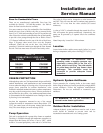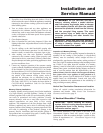
Hydronic Heating Boilers and
Domestic Water Heaters
10
INSTALLATION
Continued
FIG. 7 Outside Combustion Air - Two Openings
2. Outside Combustion Air, Using Ducts
You can direct outside combustion air to this unit using two air
ducts to deliver the air to the boiler room.
Each of the two openings must have a minimum free area of
one square inch per 2000 Btu input (11cm
2
per kW).
FIG. 8 Outside Combustion Air Through Ducts
3. Outside Combustion Air - Using Direct Venting
With this option, you can connect combustion air vent piping
directly to the unit. See the information under Direct Venting
starting on page 22 for specific information regarding this
option.
4. Combustion Air from Interior Space
You can direct combustion air to this unit using air from an
adjoining interior space. You must provide two openings from
the boiler room to the adjoining room.
Each of the two openings must have a net free area of one
square inch per 1000 Btu input (22cm
2
per kW), but not less
than 100 square inches (645cm
2
).
FIG. 9 Combustion Air from Interior Space
All dimensions are based on net free area in square inches.
Metal louvers or screens reduce the free area of a combustion
air opening a minimum of approximately 25%. Check with
louver manufacturers for exact net free area of louvers. Where
two openings are provided, one must be within 12" (30 cm) of
the ceiling and one must be within 12" (30 cm) of the floor of
the mechanical room. Each opening must have a minimum net
free area as specified in TABLE–C, page 14. Single openings
shall be installed within 12" (30 cm) of the ceiling.
The combustion air supply must be completely free of any
flammable vapors that may ignite or chemical fumes which
may be corrosive to the unit. Common corrosive chemical
fumes which must be avoided are fluorocarbons and other
halogenated compounds, most commonly present as
refrigerants or solvents, such as Freon, trichlorethylene,
perchlorethylene, chlorine, etc. These chemicals, when burned
form acids which quickly attack the heat exchanger finned
tubes, headers, flue collectors, and the vent system. The result
is improper combustion and a non-warrantable, premature unit
failure.


















